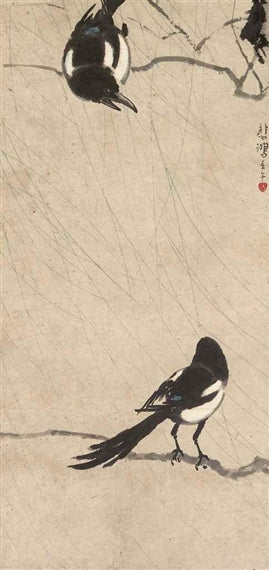Description
Xu Beihong, one of the most influential Chinese artists of the twentieth century, manages to capture the essence and life of nature in his work "Miná Birds" of 1942. This painting It is an eloquent testimony of its mastery in the merger of traditional Chinese techniques with western influences, and highlights its ability to transmit emotions and atmospheres through a seemingly simple composition.
In "Miná Birds," Beihong presents a scene of posadas poultry in a serene landscape. The paint focuses on the figure of the Miná birds, known for its dark and bright plumage, as well as its ability to imitate sounds. Three birds are observed in the work: one of them rests at the center of the composition, while the other two seem to interact in a delicate equilibrium game, capturing the dynamism and sociability of these creatures. Birds are represented with great attention to detail, evidencing the artist's technical skill in the use of precise and careful brushstrokes.
The composition is dominated by dark and terrible tones, with a white background that highlights the figure of birds. This strategic use of empty space is a characteristic element of the traditional Chinese style known as "Liubai," where unpaid spaces are as important as those filled with color. The minimalist fund does not distract from the main subject, but accentuates the feeling of silence and contemplation. This approach gives birds an almost ethereal presence, suggesting both their fragility and its connection with the surrounding environment.
It can be seen that "Miná Birds" encapsulates an aesthetic philosophy that goes beyond mere representation. Beihong uses the contrast between the solid forms of the birds and the vacuum of the background to create a sense of harmony and balance. This concept of visual balance is fundamental in Chinese art, where the interaction between the full and empty reflects a deeper understanding of the natural and spiritual world.
In addition, the work has a particular resonance in the historical context in which it was created. In 1942, China was in the midst of turbulence due to the Second Sino-Japanese war. Beihong's work was often interpreted as a form of cultural resistance and a call to the preservation of national identity. Miná birds, with their imitation capacity, can be seen as a symbol of Chinese resistance and its ability to adapt and perseverance despite adversities.
The treatment of color in the paint is sober but effective; The grays and blacks of the bird feathers are executed with a nuance and a variety of tones that provide unusual depth inside a limited palette. This chromatic precision helps distinguish textures, from the soft feathers to the firm branches in which the birds rest. The lack of vibrant colors does not decrease the vitality of the work; On the contrary, it reinforces the tranquility and introspection that the scene suggests.
Xu Beihong, through "Miná Birds," demonstrates its ability to combine Western techniques with oriental sensitivity, creating a work that is both intimately China and universally accessible. The delicacy and power of nature are captured in this painting With exceptional grace, making it a prominent example of how art can be a way for contemplation and connection with the natural world and, at the same time, a reflection on the historical and cultural circumstances of the moment.
In the contemplation of "Miná Birds," one not only appreciates the technical ability of Xu Beihong, but also immerses himself in a silent but deep dialogue about beauty, resistance and balance, issues that remain as relevant today as what They were in China from the mid -twentieth century.
KUADROS ©, a famous paint on your wall.
Hand-made oil painting reproductions, with the quality of professional artists and the distinctive seal of KUADROS ©.
Art reproduction service with satisfaction guarantee. If you are not completely satisfied with the replica of your painting, we refund your money 100%.

